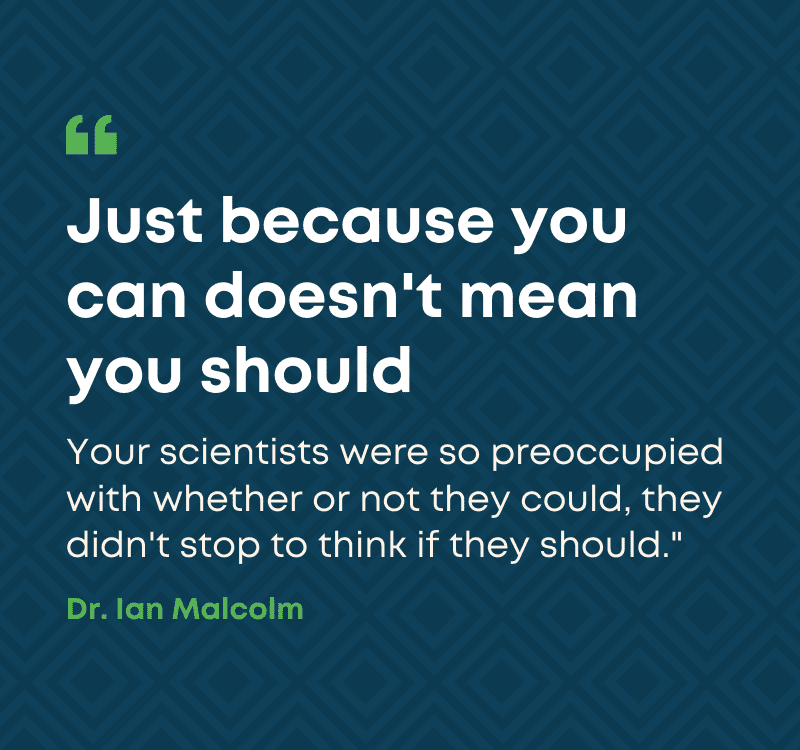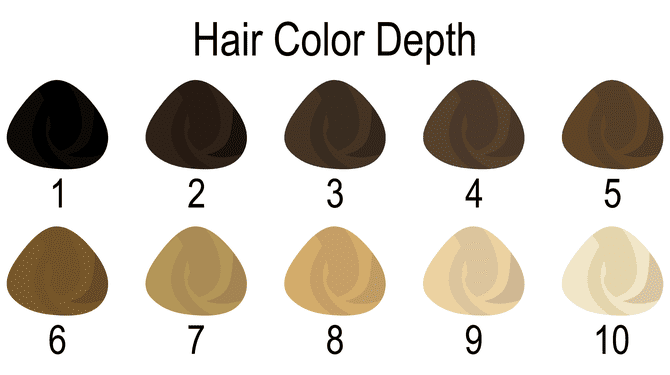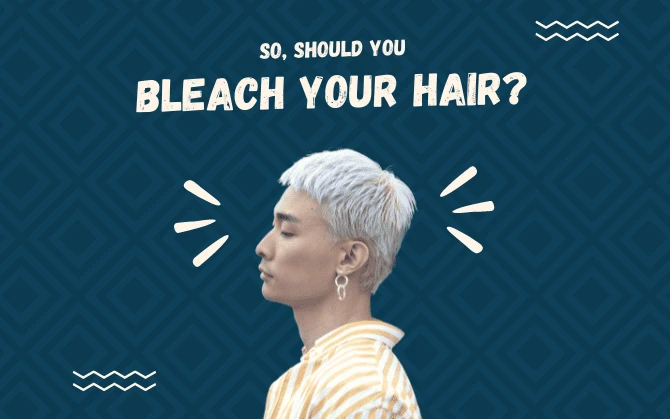Jump to:
“Should I bleach my hair?” It’s something every woman has asked, but many of us don’t follow through because we’re worried about damaging it. But don’t worry — we’ll show you whether or not you should bleach your hair.
Should You Bleach Your Hair?
It’s smart to weigh the pros and cons before deciding to reach for the bleach. Bleaching your hair is a big deal. Period.
Whether you’re doing it to go blonde, platinum, or as a necessary step before dying your hair a vivid color, you should never rush into bleaching your locks.
Bleaching your hair permanently changes the color of your locks. It damages the hair on a microscopic level. It requires a ton of upkeep and a commitment to continually maintain your new, lighter shade.
If bleaching is the only way to achieve the hair color you want, you need to ensure your hair is a good candidate for bleaching before you take the plunge.
The Quick Answer:

Anyone can bleach their hair, but not everyone should. Like Dr. Ian Malcolm famously said in Jurassic Park, “Your scientists were so preoccupied with whether or not they could, they didn’t stop to think if they should.”
Bleaching already damaged, unhealthy hair can have nightmarish consequences. Think mushy, melted hair. Major thinning and breakage. Crispy ends that feel like straw.
But bleaching healthy hair isn’t bad. If your hair is strong enough to withstand the damage bleaching causes, it’s a great way to get the lighter color you want. The trick is knowing if your hair is truly healthy enough to subject to bleaching.
So, should you bleach your hair? We’ve made it easy to find out. Below, you’ll see a list of questions about the state and condition of your hair, your current hair care routine, and your willingness to commit to monthly maintenance after bleaching.
You’ll have a better idea of whether or not bleaching is worth it by the time you’re done. Let’s take a look at those questions!
Should I Bleach My Hair? 5 Questions to Ask Yourself First
Don’t book an appointment until you’ve read through and asked yourself these five important questions. You’ll be so glad you did!
1. When Did You Last Process Your Hair?
- More than three months ago: Safe to bleach
- Less than three months ago: Wait to bleach
Bleaching your hair subjects it to a lot of damage down to a microscopic level. This is why the first thing to consider is the last time you exposed your hair to damage from chemical processing. You don’t want to double down on damage!
Chemical processing includes any chemical that changes the structure, texture, or color of your hair, like:
- Hair color
- Bleaching
- Perms
- Straightening treatments
- Relaxers
If you’ve done any of the above within the last three months, you need to hold off on bleaching your hair for now. It needs a little more time to recover from the damage caused by chemical processing before you bleach it.
You can speed up the recovery process by avoiding styling with hot tools, using nourishing, moisturizing hair masks and treatments, and taking extra care to be gentle with your hair.
If you haven’t chemically processed your hair in the last three months, you might be a good candidate for bleaching. Move on to question 2 to get a better idea of whether or not bleaching will work for you.
2. What’s Your Current Hair Color?
Assuming you haven’t colored, permed, or bleached your hair in the last three months, the next thing to consider before bleaching is your current hair color and the color you want to reach.
When you bleach your hair, you’re lifting the current color to make it lighter. Your current color, or starting point, will determine how far you have to go to reach the finish line (your desired color).
Whether it’s natural or dyed, your hair color level can be anywhere from 1 (black) to 10 (the lightest blonde).

Sidhe/Shutterstock
Bleach and developer are used to lift the hair color to the desired level. Stylists choose the developer strength based on how many levels of lift you’ll need to reach your desired color level.
- 40 volume: Lifts 4 levels; damages hair the most
- 30 volume: Lifts 2-3 levels
- 20 volume: Lifts 1 level
- 10 volume: Deposits color with no lift; damages hair the least
The closer to black your hair is, the more damage it will sustain during bleaching. There are three reasons for this:
- Dark hair takes longer to lift. This means the bleach stays on the hair longer, giving it more time to damage the hair.
- Bleach can only lift up to 4 levels at a time. This means multiple bleaching sessions may be required for dark hair to reach those ultra-light blonde levels.
- Dark hair requires a powerful developer to lift the hair the maximum amount. Stronger 40 volume developer causes more damage to hair.
So, if you’re starting with hair that is level 1-5 (anywhere from black to light brown), you can bleach your hair, but you shouldn’t expect to reach your desired color in one session. To avoid damaging your hair to the point of breakage or melting, it may take 2 or 3 sessions to reach your desired color.
You’re also going to have a lot more maintenance to deal with as your dark roots start growing in, so keep that in mind. If you’re starting with hair that is level 6+, you can definitely bleach your hair without causing too much damage.
You might be able to use a 30 volume developer to get your desired level of lift, which is much less damaging than 40 volume. Usually, it’s safe to bleach to your desired level in one session when you’re starting with hair anywhere from dark blonde to very light blonde.
3. What’s Your Hair Care Routine Like?
What kind of stuff is your hair exposed to on a daily basis? This is an important thing to think about before you decide to bleach your hair.
Your normal hair care routine plays a major part in how “bleachable” your hair is. You need to be willing to make some changes to your routine if you plan on bleaching your hair.
If you use hot tools to style your hair every day, you’ll either need to cut back drastically or accept that bleaching might not be a good idea. Hot tools damage the hair with each use, even when you use a heat protectant first. Heat damage on top of chemical damage can ruin your hair.
If you tend to brush your hair while it’s wet, roughly towel-dry it, or sleep on a scratchy cotton pillowcase, you’ll need to make some changes before bleaching.
Only brush your hair when it’s dry (and use a boar bristle brush to cut down on damage), use a microfiber towel to gently dab your hair rather than rubbing it, and switch to a satin pillowcase to avoid causing breakage and frizz while you sleep.
Hair that has been bleached should also be shampooed less often than you might be used to – about every 3-4 days. This keeps the hair moisturized with natural oils to keep strands healthy and supple. Shampooing strips moisture, which is a recipe for disaster on bleached hair.
4. Can You Commit to the Maintenance?
Be honest with yourself before bleaching. Can you really commit to the level and cost of maintenance it’s going to require? Roots start growing in immediately and become obviously grown out by weeks 4-6.
You don’t want to go more than eight weeks in between root touch-ups after bleaching. Is this doable for you, or are you going to find yourself fed up with appointments by the second touch-up?
Since bleaching should always be done by a professional (seriously – please don’t attempt to bleach your own hair!), this level of maintenance can become an annoyance fast.
You’ll be booking almost monthly appointments and paying for each visit. That can get expensive over time.
- You can expect to pay around $150-$200 for the initial session, but it could be much more expensive in certain areas or if your hair is super long, thick, or slow to lift.
- For each root touch-up after that, you’ll be paying around $40 to $60+ per visit.
Considering you might need as many as 12 salon visits in a year and pay something like $860 in a year to get and maintain bleached hair, this is something to think about seriously before you commit.
Just an idea: You can always opt for a lower-maintenance option like balayage or ombre hair color that doesn’t include the roots to reduce your maintenance costs and still get a look you’ll love.
5. Who’s Going to Bleach Your Hair?
The final thing to consider before bleaching your hair is who’s going to do it. Ideally, you have a trusted hairstylist who knows your hair well, but you’ll need to do some research if you don’t have a great one.
There’s a lot that can go wrong with bleach. That’s why you want a skilled, experienced stylist who specializes in bleach and blonding if this is the route you want to go.
You need a stylist who isn’t afraid to tell you that bleaching is a bad idea right now, or that your desired color will take two spaced-apart sessions to reach.
A great stylist will consult with you to find out what you want and whether it’s realistic for your hair right now. They’ll also be able to give you specific recommendations on products and treatments to keep your hair healthy after bleaching.
If you were planning on bleaching your own hair or having a friend or family member do it, abort! Abort! You might be able to cut your own hair, apply at-home hair color just fine, or even do your own perms or relaxers. But you absolutely must have a professional bleach your hair.
The laundry list of things that can (and usually do) go wrong with DIY bleaching is just depressing. Trust us on this one – you need a pro for bleaching. No one ever regretted paying a professional to do the job right!
If you don’t have a great stylist specializing in bleach and blonding yet, we’ve got you covered. Use our Salon Finder to see all the hair salons in your area now. You’ll be able to take your pick from the finest salons in your city to ensure your hair goals are met.
So, Should You Bleach Your Hair?

With all this in mind, should you bleach your hair? It depends on your answers to the important questions we’ve posed. Let’s sum it up briefly.
You should be fine bleaching your hair if…
- You haven’t processed your hair in the last three months
- Your current hair color is level 6 or higher, or you’re okay with doing 2+ bleaching sessions
- You’re okay with reducing heat styling, shampooing less, switching to gentler hair products, and making other swaps that are less damaging on hair (satin pillowcases, microfiber towels, etc.)
- You’re okay with salon visits every 4-8 weeks for root touch-ups and maintenance
- You understand that bleaching and touch-ups could cost somewhere in the range of $590-$860+ in a year
- You already have a trusted stylist to go to, or will commit to find a great stylist near you
You should avoid bleaching right now if…
- You’ve processed your hair chemically in the last three months
- Your current hair color is very dark, and you want a light blonde color in 1 session
- You can’t live without heat styling, shampooing daily, or other damaging routines
- You won’t commit to salon visits every 4-8 weeks, or can’t afford the cost of upkeep
- You plan to bleach it yourself or have an unlicensed friend or family member do it
If you want to go lighter, bleaching is the only way to make it happen. As long as you make your hair’s health the main priority, bleaching your hair can be a wonderful thing. But it’s not for everyone.
Be honest with yourself before you opt for bleach. Take full stock of what you’re working with – your hair’s current color and condition, your hair care routine, your budget, your stylist – before you make your final decision.
And when in doubt, ask an experienced stylist for their opinion. You might learn that bleaching was a possibility when you thought it wasn’t!
